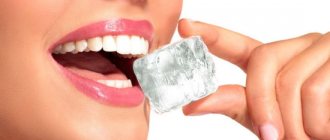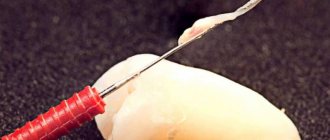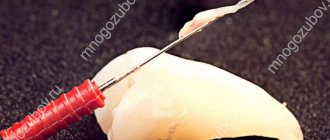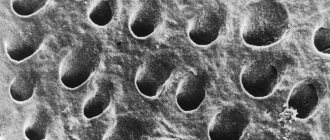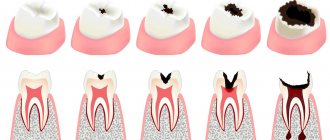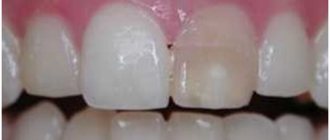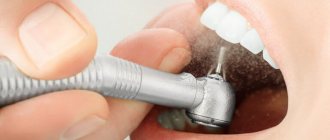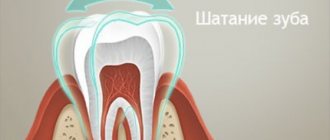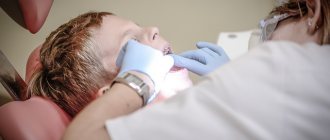- January 18, 2019
- Dentistry
- Elena Zhmakina
Intense toothache may indicate an inflammatory process affecting the nerve. Pulsation radiating to the temple or neck, increasing pain at night and in a lying position are just a few of the main symptoms that indicate that the dental nerve needs to be removed. A dentist can professionally carry out this procedure, but it is not always possible to immediately get to him at the first symptoms. And at such moments, when not a single painkiller alleviates the condition, a person asks the question: is it possible to kill the dental nerve at home?
Why remove nerve endings?
Under the crown of the tooth there are nerve endings. They spread through the canals and reach the tooth roots. Nerves provide unity between the dental system and the central nervous system. They have their own sensory function. Pain in a tooth is a signal that indicates that the soft layers under the crown have undergone destruction.
As a result of depulpation (this is the removal of a bundle of nerves in the tooth canal), the pain goes away. After this procedure, the nutrition of the tooth ends. Subsequently, you will just need to monitor the crown and visit the dentist regularly. If you do not do this, the tooth will turn black and decay.
It is possible to save a nerve if a person asked for help in time, and did not look for an answer to the question of how to properly kill a dental nerve, and did not try a lot of different remedies on himself. Even if partial damage to the pulp has occurred, there is still a chance to neutralize the area without removing the pulp.
If you regularly visit a specialist, you may never encounter such problems.
How long does it take to die
Killing the nerve is called a devitalization procedure. This relieves periodic pain when eating cold, hot or sweet foods. The nerve dies from a day to several days or even months - it all depends on the method used for this. If a special remedy is used, then you won’t have to wait long - the well-known arsenic neutralizes nerve endings within 24 hours or even less.
If the decision was made not to touch the entire destroyed tooth, then you will have to endure periodic unbearable pain for several months - killing occurs due to developing dangerous bacteria. It is prohibited to resort to such a method, because it is fraught with the formation of a cyst due to the discarded “waste” into the gums and pulp.
This is important: Devitalization involves stopping the nutrition of the tooth, so after some time the crown will darken. The way out of the situation is treatment - the use of a filling will close the exposed roots and gums, and also prevent darkening of the bone part.
When is nerve removal indicated?
If a person experiences severe pain that intensifies at night, and there is pulsation, then in this case depulpation cannot be avoided. But there are situations when there is no pain, but you still have to remove the nerve. Before answering the question of how to kill a dental nerve, let’s look at the reasons that lead to such a procedure:
- Pulpitis. These are the consequences of previously untreated caries, which gradually destroys the tooth and reaches the pulp, causing an inflammatory process. As a result, pain appears that requires radical measures: removal of the nerve and filling of the canals.
- Cyst or granuloma. They also contribute to the disruption of the sensitive area of the tooth and are removed only through the canals.
- Tooth injury. Any damage results in damage to the tooth enamel, which affects the nerve. If the frontal area is injured, then complete depulpation is performed. If the problem affects the back teeth, it is possible to partially remove the nerve.
- Prosthetics. If a person needs to get a bridge or crown, then the nerve must first be killed. This way you can reduce the risk of developing inflammation under the crown.
A specialist knows how to kill the dental nerve, so at the first symptoms it is better to seek qualified help.
What is strictly forbidden to do
There are also several strict restrictions and prohibitions that must be observed to avoid unwanted consequences. Here are the main ones:
- you can’t heat the causal area - no hot compresses, which only intensify the pain and provoke the spread of inflammation,
- you should not take a horizontal position - this will increase blood flow to the painful area, which will make the unpleasant sensations even more intense,
- Under no circumstances should you use needles - some try to pick out the cavity themselves, but this is strictly prohibited. Otherwise, you can provoke severe bleeding and even infection.
In no case should you attach a heating pad to an inflamed nerve.
Killing and removing a nerve from a tooth, even in dentistry, is considered a serious procedure that requires the proper experience and dexterity from a specialist. Therefore, in case of inflammation of the pulp, the help of a qualified specialist – an endodontist – is required. This is not a case where you can do it on your own. Don't risk your health.
1According to information at the office. manufacturer's website: vladmiva.ru.
Manifestations and causes of nerve inflammation
You can determine that the nerve of a tooth is inflamed by several signs:
- Increased pain when turning or tilting the head. The pain spreads to several teeth at once; it is difficult to determine which one hurts.
- Constant discomfort in the neck and temple area.
- An inflamed nerve quickly reacts to any irritant: hot and cold water, the same reaction can be expected from sweets.
Only a dentist can determine exactly what the reason is and choose the best medicine that kills the dental nerve.
Causes of pathology
Could the most sensitive part of the tooth be exposed? Yes, access to it opens when hard tissues are destroyed, which most often happens due to untreated caries. First, bacteria and their metabolic products corrode the enamel-dentin layer, forming a large cavity. And then they penetrate into the pulp through the dentinal tubules[1], causing inflammation and provoking pulpitis, periodontitis and other more severe complications, for example, periostitis, abscess. Sometimes the pulp is exposed under the influence of directed mechanical force, injuries and blows received in the area of the maxillofacial apparatus.
On a note! Some complain about exposed dental nerves and are interested in how to relieve pain that occurs from cold, sour, sweet and hot foods, or mechanical stress. This pain is of a sharp, short-term nature. In fact, in this case, we are most often not talking about caries and pulpitis, but about such a phenomenon as enamel hyperesthesia.
How to properly prepare for house removal?
Before answering the question of how to remove a dental nerve at home, you need to prepare for this procedure:
- Clean the canals well to prevent suppuration. This can be done with a toothbrush and toothpaste, removing plaque and all food debris.
- Take a needle, disinfect it in alcohol and clean the hollow in the tooth with the non-sharp side.
- Use chamomile decoction to rinse your mouth or apply a special dental elixir.
Only after such manipulations can you begin to remove the nerve.
Is it possible to kill a dental nerve at home? Yes, you can, but this does not mean that the work is over and you can live without worrying about anything. After the procedure, it is necessary to remove the nerve fibers, otherwise infection may begin.
Main indications for depulpation
- Deep caries. It’s not for nothing that dentists convince patients to visit their offices at least once every six months. Caries can occur completely unnoticed and painlessly, but a small black dot can grow in a short time and reach the soft tissues, then depulpation can no longer be avoided.
- Correction of the consequences of unsuccessful treatment. When removing hard carious tissue, the doctor may get too close to the pulp chamber and inadvertently open it. Then you will have to carry out, if not complete, then partial amputation of the nerve.
- Prosthetics. The technology for installing most fixed dentures involves opening the hard tissues of the tooth and manipulating the pulp chamber. In this case, it is impossible to do without removing the nerve, especially if the tooth grows at an angle.
- Injuries and mechanical damage. The consequence of a strong blow can be damage to the enamel and deep chips, inevitably affecting the nerve. In this case, it is unlikely that it will be possible to preserve it, especially in the front teeth. If the extreme molars are affected, then there is a possibility of saving some of the nerve endings by performing only partial depulpation.
Important! Prolonged acute toothache is one of the main signals that caries has already reached the pulp chamber. But it happens that the chronic form of pulpitis is absolutely painless and is detected only with a thorough dental examination. Therefore, if the doctor insists on removing the nerve, you should trust him.
How to quickly kill a dental nerve: simple methods
There are a lot of available remedies to kill the nerve, always at hand at home. Here are some effective methods that will help alleviate the condition and wait until you visit the dentist:
- Salt. This is the simplest remedy to help get rid of toothache. In 1 tbsp. warm water should be diluted with 1 tsp. salt and rinse your mouth with this saline solution. As a result, acute pain can be relieved.
- Salt and garlic. Pass a clove of garlic through a press and rub with salt. Place the resulting pulp on the sore tooth. This remedy has an analgesic and antimicrobial effect. If swelling of the gums is observed, you can additionally rinse your mouth with a decoction of garlic.
- Propolis tincture. You can purchase it at any pharmacy or prepare it yourself. You will need to take 30 g of raw material and pour a glass of alcohol, leave in a dark place for 10 days. If you soak a cotton swab in the tincture and place it on the tooth, the pain will go away.
- 3% hydrogen peroxide. It is diluted with water in a ratio of 2:1, moistened with a cotton swab and placed on the sore tooth.
- Onion peel. Pour a small handful of husks into 2 tbsp. boiling water, let it simmer over low heat. Strain the broth, leave for 2 hours, and then use it to rinse the mouth.
- Herbal infusions are good for soothing pain. Chamomile, mint, sage, thyme and oak bark are suitable for this. You only need to rinse with warm broth.
These methods will not harm human health, but they are not always effective.
Procedure
- Grasp the tooth, cover it with a sterile bandage, and pull. Keep shaking it. You can use forceps, pliers, tweezers.
- Do not squeeze the tooth too hard to prevent it from cracking.
- From time to time, try to pull it firmly, but without jerking, so as not to break off part of the root and cause an inflammatory process.
- Act smoothly, rocking the tooth and periodically trying to pull it out. Jerking is unacceptable, as you can damage the gum or break the root. Then it is no longer possible to do without the help of a surgeon.
After successful extraction:
- Place a sterile swab on the hole for half an hour.
- Remove it without disturbing the formed clot.
- Do not eat for three hours.
- Monitor the condition of the gums in the injured area, rinse your mouth with vodka, potassium permanganate solution, hydrogen peroxide or other disinfectant.
- You can use a decoction of oak bark to speed up healing and reduce pain.
To remove a tooth root you need to prepare:
- Spitting container;
- Antiseptics;
- Pain reliever;
- Gauze Swabs and pads;
- Mirror.
These tips should not be resorted to if it is possible to turn to a professional, since root extraction is a rather serious and risky operation.
Cardinal methods
If rinsing and lotions do not help, then how can you kill the dental nerve at home? There are several drastic methods, but they can cause serious harm, so they are recommended to be used only in difficult cases and with extreme caution. Here are a few remedies:
- Vinegar essence. You need to moisten a cotton swab in it and place it carefully in the hollow of the tooth. But initially you need to thoroughly disinfect your hands to prevent infection. The procedure must be carried out carefully so as not to burn the gums.
- Alcohol. If rinsing with alcohol tinctures does not give any results, then you can moisten a cotton swab in medical alcohol and place it in the hollow of the tooth.
- Zinc. Not everyone has this substance in their home, but you can extract it yourself from printing ink. You need to take a sheet of newspaper with a large black design, crumple it up and set it on fire. Use a cotton swab moistened with human saliva to collect the ashes and place them in the tooth. This procedure is painful, so it is recommended to take a painkiller 20 minutes before the procedure.
Whatever method is used at home, you need to remember that this is a temporary measure; a visit to the dentist should still be necessary.
Medications
You can kill the nerve in a tooth at home using pharmaceutical medications. To do this, you can use special dental pastes that do not contain arsenic. These include “Devit-P” and “Devit-S”. You need to brush your teeth well, clean the canals from food debris and put a pea of paste in the hollow, fix it with dental glue recommended for fixing dentures. All this can be easily purchased at any pharmacy, and it is safe for health.
When choosing pharmaceutical products that kill the dental nerve, you need to remember that some of them may contain arsenic, which can be harmful to health if used incorrectly. It is better to immediately check the composition of the drug with a pharmacist or read the instructions for it.
Professional treatment
Its tactics and volume are determined by the doctor, and it depends on the causes of the problem and the condition of the diseased tooth. After an in-person examination, if necessary, the specialist sends the patient for an x-ray in order to accurately determine the location of the lesion and examine the condition of the root and dental tissues.
Based on a preliminary study, the following assistance can be provided to the patient:
- Treatment of caries;
- Depulpation of the tooth with treatment and subsequent filling of the dental canals;
- If its tissues are severely damaged, it may be necessary to install a crown or other types of prostheses (for example, veneers, lumineers);
- If the cause of the pain lies in a root disease, if possible, it is treated by opening the canals. It is possible that resection of its apex will be required to eliminate the source of inflammation and preserve the tooth;
- In some cases, it is not possible to avoid completely removing the latter.
If discomfort occurs after filling, and the reason lies in improper treatment, the filling is opened, the canals are treated, if necessary, and then the filling is repeated.
What should you not do if you have severe tooth pain?
We have already described several ways to kill the dental nerve at home, but there are procedures that should never be done, otherwise the consequences will be disastrous:
- Warming up. Hot compresses will only worsen the symptoms.
- Rest in a lying position. In the lying position, blood circulation is activated, and blood flows faster to the teeth. As a result, the pressure increases and the pain syndrome intensifies.
- Using a needle. Do not penetrate into the hollow of the tooth with a sharp needle, as this can damage soft tissues and cause bleeding.
All these methods lead to serious and irreversible consequences, which will then take a long time to eliminate in the dental office.
Symptoms
You can find out about the destruction of the pulp and the impact on the dental nerve by the existing unpleasant symptoms :
- prolonged pain - in most cases occurs after eating cold or hot, indicates inflammation of the pulp, tissue death;
- severe – acute pain can also cause the development of pulpitis, often indicating the formation of a crack in the dentin (the second layer of the tooth);
- aching - this type of pain indicates the beginning of destruction and partial exposure of the pulp;
- attacks - pain occurs only when pressure is applied to the tooth.
The formation of a characteristic unpleasant sensation when cold or hot is also noted. This occurs due to increased sensitivity of the tooth, which is the result of exposure of the nerve or root. Sometimes such symptoms indicate improper use of a toothbrush or the use of inappropriate toothpaste, which gradually leads to abrasion of the enamel.
How to remove a nerve at home?
This method of treatment is considered prohibited, because a person can harm his health. Dentists recommend resorting to it only if other methods have not helped, you can’t get to a specialist, and the pain does not calm down.
Pulp removal at home must be carried out carefully, after first assessing the patient’s condition and determining whether there is periodontitis, an infection. If the gums are inflamed and the pain spreads to several teeth at once, then the procedure is dangerous. It's better to see a doctor.
Before removal, clean the cavity well, put in it homemade medicine or purchased at a pharmacy, which will kill the nerve.
Preparation before home depulpation
At home, you can kill the nerve of the tooth or reduce its sensitivity. In the first case, you will have to destroy the crown part of the tooth to get to the problem area.
Before suppressing the sensitivity of the structure, the following preparatory measures are performed:
- Decide whether it is necessary to kill the dental nerve or reduce its susceptibility to external irritants. The method of relief will depend on the intensity of the pain and the qualifications of the person who will carry out emergency measures.
- Treatment of the oral cavity with antiseptics.
- Cleaning the canals with a needle. It is preheated over a fire and treated with disinfectants, for example, Miramistin or Chlorophyllipt.
- Repeated antiseptic treatment of the mouth.
What to do when the nerve is removed?
After depulpation at home has been carried out, you need to thoroughly clean your mouth with running water and go to the dentist. If the dead pulp is not removed in time, it can lead to osteonecrosis of the jaw.
After the procedure, it is recommended to rinse your mouth with medicinal herbs, which help relieve inflammation and prevent infection. Chamomile is suitable for these purposes. But you shouldn’t delay going to the dentist; this should be done no later than two weeks after the nerve is removed.
How do dentists remove a nerve?
Just 20 years ago, it was not possible to perform the nerve removal procedure in a doctor’s office in one go. But today, thanks to effective anesthetic agents, everything is possible. Initially, the doctor will numb the tooth, then clean the canal to get to the pulp. He will remove it and install a temporary filling. Only at the next visit, which may be scheduled in a few days, will the doctor be able to place a permanent filling, making sure that the removal of the nerve endings was completed correctly and without complications.
In addition to removing the pulp, the doctor may recommend partially removing the nerve, but he can make such a decision if the patient is a teenager or a child; in adult patients, the nerve is completely removed.
There is nothing difficult for a specialist in this procedure; immediately after the injection the patient feels relief, and after removal of the nerves the pain does not return. To prevent this condition, it is better to seek help immediately after discomfort appears in the tooth or a hole is discovered.
How to kill the pulp in dentistry
As for how to kill a nerve in dentistry, specialists for this purpose use two methods of depulpation - vital and devital. The first option involves amputation of the inflamed vascular bundle in one visit, under anesthesia. With the devitalizing method, the removal is carried out in two steps: at the first appointment, the doctor puts a devitalizing paste into the tooth and places a temporary filling on top, and at the second, he amputates the already dead pulp.
Quite aggressive arsenic compounds are used for killing. But today they are gradually being replaced by less toxic formaldehyde pastes. Below we will take a closer look at exactly what medications are used to kill the nerve.
Devitalizing pastes with arsenic: “Devit-Ars” and “Kaustinerv Rapid”
The basis of the drug "Devit-Ars" is arsenic anhydride. It leads to the gradual death of soft tissues and fairly rapid death of the pulp. To make this process painless for the patient, the composition also contains lidocaine.
The photo shows arsenic paste
It should be noted that the process of necrosis of living tissue requires strict control by a doctor, otherwise the consequences for the body can be very serious. It is very important to provide reliable protection against infection during this time. For this purpose, antiseptics are also added to the Devit-Ars paste - eugenol, chlorophenol and metacresol. As a rule, killing with this drug occurs literally within 24 hours1. In rare cases, the process takes a little longer, but usually no more than 2 days.
"Caustinerv Rapid" is another popular devitalizing drug in dentistry based on the same active substance. The composition also contains lidocaine, phenol, hydrochloric ephedrine and menthol. The devitalization process takes on average 2-3 days.
Arsenic-free pastes - formaldehyde
One of the most popular drugs in this category is Devit. It is based on paraformaldehyde, the action of which is aimed simultaneously at killing the pulp and antiseptic treatment of tissues. Lidocaine acts as an anesthetic component, and creosote is responsible for the antimicrobial properties.
Paste without the presence of arsenic can be used
To perform its immediate task, this formaldehyde paste requires much more time - up to 10 days. On the other hand, this is a much more gentle and safe method that poses virtually no threat to the body. Another important advantage of this type of devitalizing agents is the deep sterilization of the pulp chamber, which often makes it possible to preserve tissue at least partially.
Important! After arsenic paste, the doctor must carry out a very thorough treatment of the canals and make sure that there are no traces of a toxic substance there. When using formaldehyde compounds, this step can be skipped.
After 2 to 10 days, depending on the type of composition used, the patient needs to visit the doctor again to complete the treatment. He will remove the temporary filling, remove dead tissue, treat the canals and seal them. A permanent filling will be placed on top and sent for a control x-ray.
Complications
Finding the answer to the question of how to kill the dental nerve is only half the battle; you also need to think about what complications a person can expect. He may encounter the following problems:
- Allergy to the drug used to kill the nerve. An allergic reaction can cause swelling of the larynx and stop breathing.
- Damage to healthy tissues located in the immediate vicinity. Often, an inexperienced person who decides to remove the dental nerve on his own during the procedure affects healthy tissue, as a result of which the dentist has to restore not only the teeth, but the entire oral cavity.
- Burns, taste disorder. If you do not follow the dosage of the drug that is used to kill the dental nerve, this can lead to a burn of the mucous membrane. As a result, you will no longer be able to taste food normally. Problems with swallowing will also begin to appear.
- Tooth infection. Often, when killing a nerve at home, people get an infection. Bacteria enter the tooth cavity through poorly disinfected instruments or dirty hands.
If possible, it is better to seek help from a dentist. The consequences are often much more painful than removing the nerve.
In what cases is it necessary to kill him?
The dental nerve is killed in most cases for painless treatment. Moreover, deformation of the pulp - drilling the tooth to apply a filling - will subsequently provoke partial “exposure” of the nerve endings. As a result, even after treatment the person will experience pain.
Among all the reasons for killing the dental nerve are:
- prosthetics;
- deep carious cavity - when caries has affected the deep layers of the pulp;
- previous poor-quality dental treatment – pain occurred after dental intervention;
- mechanical injury.
Prerequisites also include inflammation of the pulp, developing periodontitis and other destructive processes of the dental crown.
